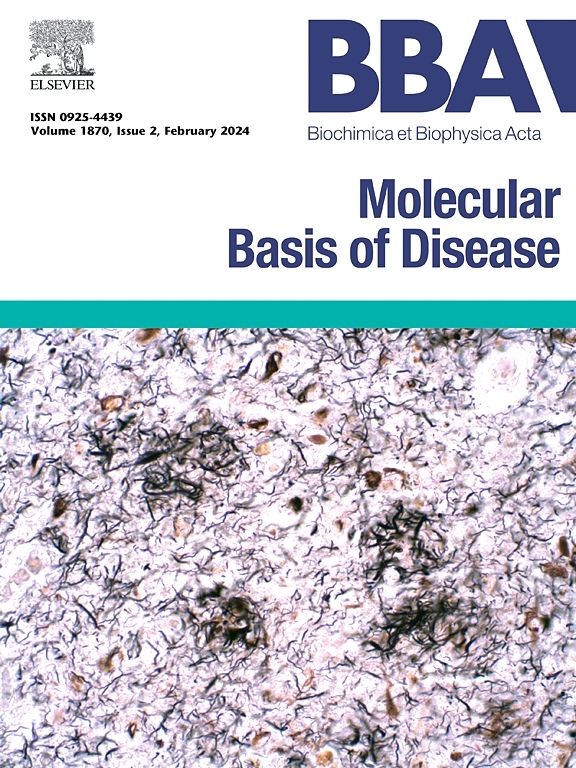ADAM9/NF-κB和ADAM9/STAT3反馈回路在HIV-1 tat诱导的小胶质细胞炎症反应和随后的神经元凋亡中的差异作用
IF 4.2
2区 生物学
Q2 BIOCHEMISTRY & MOLECULAR BIOLOGY
Biochimica et biophysica acta. Molecular basis of disease
Pub Date : 2025-04-07
DOI:10.1016/j.bbadis.2025.167831
引用次数: 0
摘要
ADAM与几种神经退行性疾病的进展有关。然而,它们在hiv相关神经认知障碍(HAND)中发挥的确切功能仍未完全阐明。HIV-1转录激活因子(Tat)具有在中枢神经系统的小胶质细胞内引起炎症反应的能力。这随后引发了神经元细胞的凋亡。在目前的研究中,我们的注意力集中在ADAM9在小胶质细胞对Tat的反应中所起的作用。我们发现可溶性Tat刺激可通过NF-κB和STAT3途径显著增强ADAM9的表达。相反,抑制ADAM9可显著降低tat触发的NF-κB和STAT3信号。此外,ADAM9/NF-κB和ADAM9/STAT3反馈回路均加剧了tat诱导的小胶质细胞炎症反应。然而,进一步的研究表明,ADAM9/NF-κB反馈回路在Tat刺激后更显著地促进了小胶质细胞分泌的条件介质介导的神经元凋亡。本研究为不同反馈回路在HAND发病机制中的作用提供了新的视角。可以假设,当作为一个整体考虑时,ADAM9可能代表一个可行的候选治疗干预,通过调节小胶质细胞的炎症反应和影响神经元损伤来预防与HAND相关的神经元损伤。本文章由计算机程序翻译,如有差异,请以英文原文为准。
Differential roles of the ADAM9/NF-κB and the ADAM9/STAT3 feedback loops in HIV-1 Tat-induced microglial inflammatory response and subsequent neuronal apoptosis
ADAM has been implicated in causing several neurodegenerative diseases to progress. However, the precise function they play in HIV-associated neurocognitive disorders (HAND) remains incompletely elucidated. The HIV-1 transcriptional activator (Tat) has the capacity to evoke an inflammatory reaction within the microglia of the central nervous system. This, subsequently, initiates the apoptosis of neuronal cells. In the present research, our attention was centered on the part that ADAM9 plays in the microglia's response to Tat. We discovered that the stimulation with soluble Tat remarkably enhanced the manifestation of ADAM9 by means of the NF-κB and STAT3 pathway. In contrast, inhibition of ADAM9 significantly reduced Tat-triggered NF-κB and STAT3 signaling. Moreover, both ADAM9/NF-κB and ADAM9/STAT3 feedback loops exacerbated Tat-induced microglia inflammatory responses. However, further studies showed that the ADAM9/NF-κB feedback loop more significantly promoted neuronal apoptosis mediated by conditioned medium secreted by microglia after Tat stimulation. This study offers a novel perspective on the function of diverse feedback circuits in the etiopathogenesis of HAND. It can be posited that, when considered as a collective entity, ADAM9 may represent a viable candidate for therapeutic intervention in the context of preventing neuronal injury associated with HAND by modulating the inflammatory response of microglia and influencing neuronal injury.
求助全文
通过发布文献求助,成功后即可免费获取论文全文。
去求助
来源期刊
CiteScore
12.30
自引率
0.00%
发文量
218
审稿时长
32 days
期刊介绍:
BBA Molecular Basis of Disease addresses the biochemistry and molecular genetics of disease processes and models of human disease. This journal covers aspects of aging, cancer, metabolic-, neurological-, and immunological-based disease. Manuscripts focused on using animal models to elucidate biochemical and mechanistic insight in each of these conditions, are particularly encouraged. Manuscripts should emphasize the underlying mechanisms of disease pathways and provide novel contributions to the understanding and/or treatment of these disorders. Highly descriptive and method development submissions may be declined without full review. The submission of uninvited reviews to BBA - Molecular Basis of Disease is strongly discouraged, and any such uninvited review should be accompanied by a coverletter outlining the compelling reasons why the review should be considered.

 求助内容:
求助内容: 应助结果提醒方式:
应助结果提醒方式:


